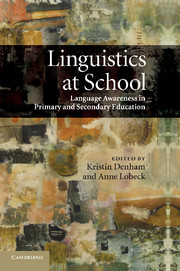Book contents
- Frontmatter
- Contents
- Notes on contributors
- Foreword: The challenge for education
- Introduction
- Part I Linguistics from the top down: encouraging institutional change
- Introduction to Part I
- 1 Ideologies of language, art, and science
- 2 Bringing linguistics into the school curriculum: not one less
- 3 How linguistics has influenced schools in England
- 4 Supporting the teaching of knowledge about language in Scottish schools
- 5 Envisioning linguistics in secondary education: an Australian exemplar
- 6 Linguistics and educational standards: the California experience
- 7 Developing sociolinguistic curricula that help teachers meet standards
- 8 Linguistic development in children's writing: changing classroom pedagogies
- Part II Linguistics from the bottom up: encouraging classroom change
- Part III Vignettes: voices from the classroom
- References
- Index
6 - Linguistics and educational standards: the California experience
Published online by Cambridge University Press: 04 August 2010
- Frontmatter
- Contents
- Notes on contributors
- Foreword: The challenge for education
- Introduction
- Part I Linguistics from the top down: encouraging institutional change
- Introduction to Part I
- 1 Ideologies of language, art, and science
- 2 Bringing linguistics into the school curriculum: not one less
- 3 How linguistics has influenced schools in England
- 4 Supporting the teaching of knowledge about language in Scottish schools
- 5 Envisioning linguistics in secondary education: an Australian exemplar
- 6 Linguistics and educational standards: the California experience
- 7 Developing sociolinguistic curricula that help teachers meet standards
- 8 Linguistic development in children's writing: changing classroom pedagogies
- Part II Linguistics from the bottom up: encouraging classroom change
- Part III Vignettes: voices from the classroom
- References
- Index
Summary
Why do citizens in a democracy need an understanding of the nature and functions of language? With some insight into the nature of language structures, their acquisition and their use, as well as awareness of language variation over time and across communities, the individual is more likely to be able to do the following:
examine attitudes toward regional, social, and “standard” dialects and the people who use them;
recognize a range of structures and registers and use them to communicate effectively at work and at home;
understand the crucial importance of language interaction for children and its impact on language acquisition and later school success;
take an informed position on political issues such as establishing English as a national language, or prohibiting bilingual education;
appreciate the variety and complexity of human languages, and linguistics as a science;
understand the nature of systematic inquiry, even as it applies to the most familiar phenomena, such as the language we develop, know, and use.
But the sustained absence of any systematic study or public awareness of language in the United States has left linguists bemused (Liberman 2007; O'Neil 1998c). Like gravity, language and its fundamental role in defining our humanness are virtually invisible. When the public does notice language, the goal typically is not inquiry and understanding, but rather a concern about usage or questions about prescription, often narrowly focused on written forms.
- Type
- Chapter
- Information
- Linguistics at SchoolLanguage Awareness in Primary and Secondary Education, pp. 76 - 90Publisher: Cambridge University PressPrint publication year: 2010



